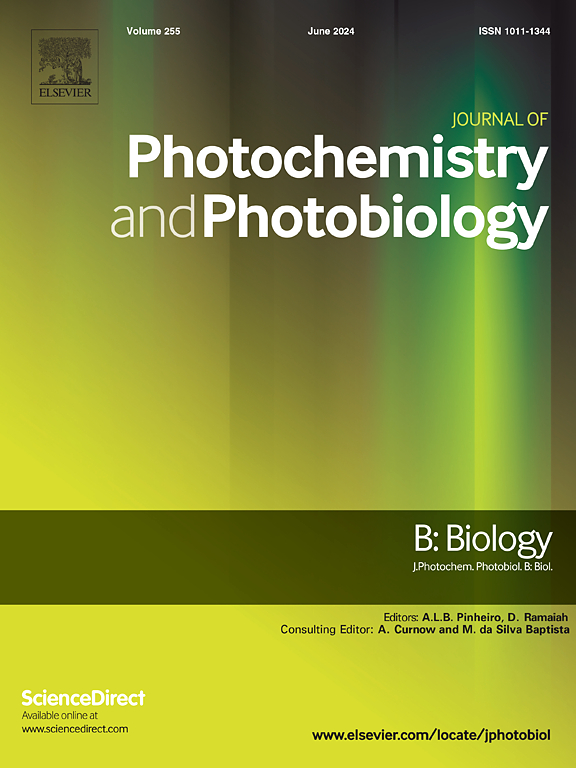Alterations in the mechanical properties of single dsDNA molecules, bare or cell-encapsulated, upon exposure to UVA-only radiation and sunlight
IF 3.9
2区 生物学
Q2 BIOCHEMISTRY & MOLECULAR BIOLOGY
Journal of photochemistry and photobiology. B, Biology
Pub Date : 2024-10-23
DOI:10.1016/j.jphotobiol.2024.113044
引用次数: 0
Abstract
Exposure to ultraviolet radiation, which leads to the formation of mutagenic and cytotoxic DNA lesions such as cyclobutane pyrimidine dimers (CPDs) and 6–4 photoproducts (6–4 PPs), can be potentially fatal. The way UVA forms DNA lesions and alters DNA topology and mechanics is still unclear, unlike the cases of UVC and UVB. Herein, Atomic Force Microscopy (AFM) and AFM-based Force Spectroscopy (AFS) have been employed to investigate the topological and mechanical properties of single DNA molecules, bare or E. coli cell-encapsulated, with or without UVA (solar or from UV lamp) treatment. It is observed that both the dsDNA transitions, i.e., ‘B' to stretched ‘S' conformation and melting transition, are lost in UVA dose-dependent manner. Presumably, this is due to formation of the CPDs and 6–4 lesions that form inter-strand cross-links, causing dsDNA strand separation difficult. Gradual reduction in DNA extension length upon prolonged treatment with UVA-only radiation or sunlight (where, 95 % of solar UV is UVA) also indicates formation of the inter-strand cross-links, since such cross-links can reduce DNA flexibility and increase DNA stiffness. Although these observations are common for both bare and cell-encapsulated DNA, the UVA dose at which the distinctive reversible B-S and melting transition faded away varied widely from 240 kJ/m2 (bare DNA) to 900 kJ/m2 (cellular DNA). The UV-induced DNA damage was also evident in observation of increased number of open circular and linearized topologies, as formed due to single-strand and double-strand breaks, respectively, at damage sites, upon combined action of the apurinic/apyrimidinic site-specific endonucleases IV and V. The extent of DNA damage was further quantified by enzyme-linked immunosorbent assay, which is found to be correlated to the single molecule information.
裸露或细胞包裹的单个 dsDNA 分子在暴露于纯 UVA 辐射和阳光下时机械特性的变化。
暴露在紫外线辐射下会形成致突变和细胞毒性 DNA 病变,如环丁烷嘧啶二聚体(CPDs)和 6-4 光致产物(6-4 PPs),有可能致命。与紫外线(UVC)和紫外线波长(UVB)不同,UVA 形成 DNA 病变以及改变 DNA 拓扑结构和力学的方式尚不清楚。在此,我们采用原子力显微镜(AFM)和基于 AFM 的力谱仪(AFS)来研究单个 DNA 分子的拓扑学和力学特性,这些 DNA 分子既可以是裸露的,也可以是封装在大肠杆菌细胞中的;既可以经过 UVA(太阳能或紫外线灯)处理,也可以不经过 UVA 处理。研究发现,dsDNA 的两种转变,即从 "B "构象到拉伸 "S "构象以及熔化转变,都会随着 UVA 剂量的增加而消失。这可能是由于 CPDs 和 6-4 病变形成了链间交联,导致 dsDNA 链难以分离。长时间接受纯 UVA 辐射或阳光照射(其中 95% 的太阳紫外线为 UVA)后,DNA 延伸长度逐渐缩短,这也表明链间交联的形成,因为这种交联会降低 DNA 的柔韧性,增加 DNA 的硬度。虽然裸 DNA 和细胞包被 DNA 都能观察到这些现象,但使独特的可逆 B-S 和熔化转变消失的 UVA 剂量差别很大,从 240 kJ/m2(裸 DNA)到 900 kJ/m2(细胞 DNA)不等。紫外线诱导的 DNA 损伤还表现在,在嘌呤/嘧啶位点特异性内切酶 IV 和 V 的联合作用下,在损伤位点处由于单链和双链断裂而分别形成的开放环形拓扑和线形拓扑数量增加。
本文章由计算机程序翻译,如有差异,请以英文原文为准。
求助全文
约1分钟内获得全文
求助全文
来源期刊
CiteScore
12.10
自引率
1.90%
发文量
161
审稿时长
37 days
期刊介绍:
The Journal of Photochemistry and Photobiology B: Biology provides a forum for the publication of papers relating to the various aspects of photobiology, as well as a means for communication in this multidisciplinary field.
The scope includes:
- Bioluminescence
- Chronobiology
- DNA repair
- Environmental photobiology
- Nanotechnology in photobiology
- Photocarcinogenesis
- Photochemistry of biomolecules
- Photodynamic therapy
- Photomedicine
- Photomorphogenesis
- Photomovement
- Photoreception
- Photosensitization
- Photosynthesis
- Phototechnology
- Spectroscopy of biological systems
- UV and visible radiation effects and vision.

 求助内容:
求助内容: 应助结果提醒方式:
应助结果提醒方式:


